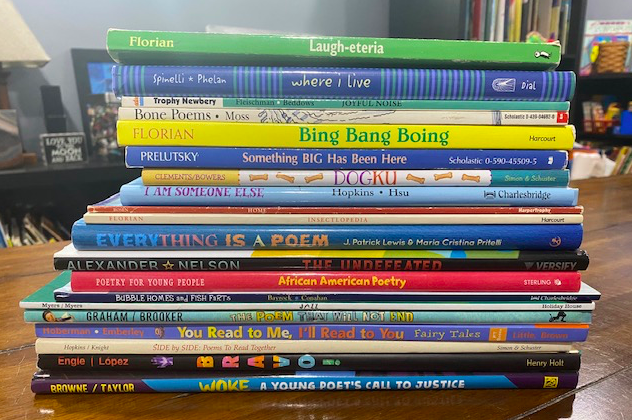We offer you Short Texts at Your Fingertips. Twice each week, we provide teaching ideas around a different type of short text that is easily found in the home, so that no family feels under-resourced. These ideas can integrate into virtually any curriculum and pedagogy, from Workshop to basal. If you are a caregiver, teacher, or curriculum director, these brief but mighty texts and lessons are our way of saying thanks. And our way of giving children authentic and enjoyable reading and writing engagements each day.
Written by Julie Wright & Elizabeth Keim
SHORT TEXTS AT YOUR FINGERTIPS: POETRY
Poems are the quintessential short text. Easy to find and usually under a page in length, poems are our “go-tos” for lots of reasons. Sometimes we use poems in the classroom whenever we need a little something extra or we use them as part of a poetry unit. We always have a few poems on deck and now is the perfect time to bring them out. There are poems about every subject imaginable and almost as many types of poems to read or write about them. There are rhyming poems and odes and poems for two voices. There are so many different types, we could really write many blog posts about poetry. For today we are going to think about just two: concrete poems and acrostic poems. Both are easy to understand, easy to write and easy to love.
An anthology — or collection of poems — is a great resource to encourage voluminous reading. You’ll find anthologies that are filled with one particular type or various types of poems. Some anthologies are authored by one poet while others by many. And, poetry anthologies can be about one subject — such as sports, weather, or honoring important people — and others are filled with poems about various topics. You can’t go wrong with a poetry anthology — there’s something for everyone!
TWO TYPES OF POEMS
TRY THIS!
Step 1
Find a poem or poems to share. We suggest you introduce one type at a time (i.e. get to know and understand concrete poems before moving onto another type of poem).
Some places to look:
Poetry books you may have on your bookshelf
Go online (So many to find!). See the resources below.
Write your own.
Step 2
Study the poem or poems you have chosen. Things to consider:
Will you show the poem first? Or read it first? Both approaches have advantages. Note: we usually show both of these types of poems before reading the words because the visual is such an important aspect of these particular forms.
Ask the readers what they notice about the way the poem looks.
Ask the readers what they notice about the words of the poem.
After studying one poem, readers can start to shape (pun intended!) their own definition of this type of poetry.
Step 3
Look for other reading, writing and talking opportunities using this short text type. Here are some examples:
Step 4
Look for other concrete or acrostic poems and read those too! You could also consider:
Write a concrete or acrostic poem and perform / read your poem to others. Make sure you display or show your poem too!
Writing an acrostic poem for each of your readers (a quick poem to brighten up their day)
Use the acrostic or concrete poem builder app (listed in resources below) to generate a poem.
Use a “found” word as the foundation of an acrostic poem
Other Fun Poetry Types to Try:
Haikus
Limericks
Free Verse
FOR MORE RESOURCES, CHECK THESE OUT!
Acrostic Poems
African Acrostics: A Word in Edgeways by Avis Harley
Acrostic Poem Generator — This is so much fun! Use it after readers really understand acrostic poems.
Kidzone — Writing Acrostic poems about specific holidays
Acrostic Poems from Pinterest
Acrostic Poems from Bing
Concrete Poems
A Poke in the I: A Collection of Concrete Poems by Paul Janeczko
Wet Cement: A Mix of Concrete Poems by Bob Raczka
Ode to a Commode: Concrete Poems by Brian P. Cleary
Blue Lipstick: Concrete Poems by John Grandits
Playful Learning website- Exploring Concrete Poetry
Concrete Poem Generator — This is so much fun! Use it after readers really understand concrete poems.
Concrete Poems from Pinterest
Concrete Poems from Bing
COMING SOON!
Short Texts: Mighty Mentors That Move Readers and Writers Forward by Julie Wright & Elizabeth Keim (2022)
CO-AUTHOR: ELIZABETH KEIM
Elizabeth Keim is a New York City based educator with more than 25 years of experience. She is currently an AIS Reading Teacher/Reading Recovery teacher for a school in Mamaroneck, New York. Previously she taught in District 2 in Manhattan, serving as a classroom teacher, reading specialist, and library teacher. In each of these roles, she knows that, "it is all about finding a text that truly captures a particular reader." She has taught Undergraduate and Graduate level courses at New York University and Bank Street College of Education, as well as workshops for teachers and parents. An avid birder, Elizabeth enjoys her time in Central Park every spring and fall. Her most thrilling sightings to date are: A rare Kirtland's warbler and the tutti frutti colored Summer Tanager.



